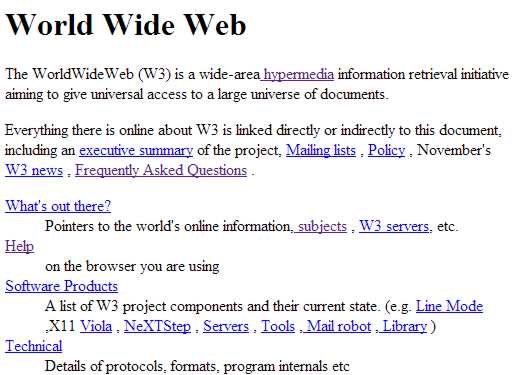| The Web - The Early Years |
| Written by Historian | ||||
Page 1 of 3 A time before the World Wide Web? Yes, there was one. In fact the Web is quite young, dating from 1991 when its inventor, Tim Berners-Lee then based at CERN, launched the first ever web site. It really is hardly credible that there was a time before “The Web” but the truth of the matter is that it is a little over 30 years ago since it was first thought of and even less since it became widely used. In fact there are a lot of users who today don't even realize that the Web is not the Internet and the Internet is not the Web. It is difficult to trace the ideas that led to the Web back to a single original thought, but there have been many attempts to find ways of organising information to make it easier to access. In 1945 Vannevar Bush wrote an article, As We May Think, describing how machines could be used create networks of information retrievable by the associations between them. The system he invented made use of microfilm readers to link information together. You can see that the technology wasn't ready for the idea but the idea was good: Consider a future device for individual use, which is a sort of mechanized private file and library. It needs a name, and, to coin one at random, "memex" will do. A memex is a device in which an individual stores all his books, records, and communications, and which is mechanized so that it may be consulted with exceeding speed and flexibility. It is an enlarged intimate supplement to his memory. In 1965 Ted Nelson invented the word “Hypertext” in an academic paper, Complex Information Processing: A File Structure for the Complex, the Changing, and the Indeterminate, and proposed a system a lot like the Web – but nothing much came of it and a similar fate was suffered by lots of very general philosophical schemes for building systems that linked knowledge together in ways that would revolutionise human thought. The problem seemed to be that deep thinkers had lots of ideas about how to make data more accessible but they lacked the key technology to implement anything that worked. It may also be that they were proposing systems that were far too complex with no small set of simple principles. The CERN connectionOne that stood out from the rest of the ideas was “Enquire”, a hypertext system implemented by British scientist, Tim Berners-Lee, to help him remember the connections between people working at the CERN high-energy physics lab. In 1980, I wrote a program for keeping track of software with which I was involved in the PS control system. Called Enquire, it allowed one to store snippets of information, and to link related pieces together in any way. To find information, one progressed via the links from one sheet to another, rather like in the old computer game "adventure". I used this for my personal record of people and modules. It was similar to the application Hypercard produced more recently by Apple for the Macintosh. A difference was that Enquire, although lacking the fancy graphics, ran on a multiuser system, and allowed many people to access the same data. After a brief spell away from CERN, Berners-Lee returned to a more permanent position there and, in 1989, submitted a proposal entitled 'A large hypertext database with typed links' to build a more ambitious hypertext system that would make use of the, by then well-established, Internet to share hypertext linked documents. The idea was to allow workers at CERN an easy way to preserve and access all of the information they were producing: " ...This is why a "web" of notes with links (like references) between them is far more useful than a fixed hierarchical system. When describing a complex system, many people resort to diagrams with circles and arrows. Circles and arrows leave one free to describe the interrelationships between things in a way that tables, for example, do not. The system we need is like a diagram of circles and arrows, where circles and arrows can stand for anything. We can call the circles nodes, and the arrows links. Suppose each node is like a small note, summary article, or comment. I'm not over concerned here with whether it has text or graphics or both." Initially his proposal received no reply but he began working on the idea nevertheless.
Tim Berners-Lee, inventor of the World Wide Web
In 1990 he wrote the Hyper Text Transfer Protocol HTTP, invented the Hyper Text Markup Language HTML, wrote a client browser and the first Web server. A later proposal described the project: The project has two phases: firstly we make use of existing software and hardware as well as implementing simple browsers for the user's workstations, based on an analysis of the requirements for information access needs by experiments. Secondly, we extend the application area by also allowing the users to add new material. Phase one should take 3 months with the full manpower complement, phase two a further 3 months, but this phase is more open-ended, and a review of needs and wishes will be incorporated into it. The manpower required is 4 software engineers and a programmer, (one of which could be a Fellow). Each person works on a specific part (eg. specific platform support). The Web server was installed at info.cern.ch and this was the very first Web server from which everything grew. The Web went public on August 6, 1991 but it was an event that was largely unnoticed by the world! To celebrate the 20th anniversary of this historic undertaking, a team at CERN set out to restore the world's first Website and to preserve some of the digital assets associated with the birth of the Web. The work done in 2013 means you can still browse the world's first Website, which was originally hosted on Berners-Lee's NeXT computer and was about the World Wide Web itself. It is well worth clicking around the replica of this primitive site to realize just how far we've come.
According to Dan Noyes on the project's blog, this first Website "was probably quite lonely" as few people had access either to browser or Web servers. One of the people who has a browser was Tim Berners-Lee and this screenshot is of the original NeXT Web browser in 1993:
It seems almost spooky to think of this very first Website, sitting there with no one able to browse it and few other pages to link to. There certainly would have been no need for Google at this point and you could correctly say "Have you visited the Website?" What exactly did Berners-Lee invent?The simple answer is HTTP and HTML. But of course you have to keep in mind that he also had the big plan of how everything fitted together to create what we now call the web. HTTP was, and is, a very simple request/response protocol. The browser sent a request for a file to the server and the server transmits the file to the browser. That’s more or less all there is to it. Over time it has been developed but it still is just a way for a Web browser to request a file. HTML was used to format the data in the files. It consisted of formatting “tags” that the browser used to present the text to the user. At first the range of tags was very limited – headers, paragraphs, italic text and so on. It had hypertext links but they weren't clickable in the manner of a modern Web page – you had to type in the reference number! Notice that the Web was built on top of the Internet as it then existed. It made use of the Internet and its lower level protocols such as TCP/IP to transmit data. For example there was no need to invent domain names or IP addresses all of this already existed as part of the Internet. HTTP simply used TCP/IP to request and send files from the server to the client browser. The browser simply rendered the HTML into a visible web page. Clicking a link in the page caused the client browser to request a file from that particular server. The idea of a domain name also had to be extended by including a file path to produce a URL. This specified the server to be contacted and the location and name of the file to be fetched. The Internet could have carried on quite happily without the invention of the Web but the Web needed the Internet as a communications infrastructure. <ASIN:0062515861> <ASIN:0822572737> <ASIN:0192862073> <ASIN:0262511150> |
||||
| Last Updated ( Monday, 08 May 2023 ) |


